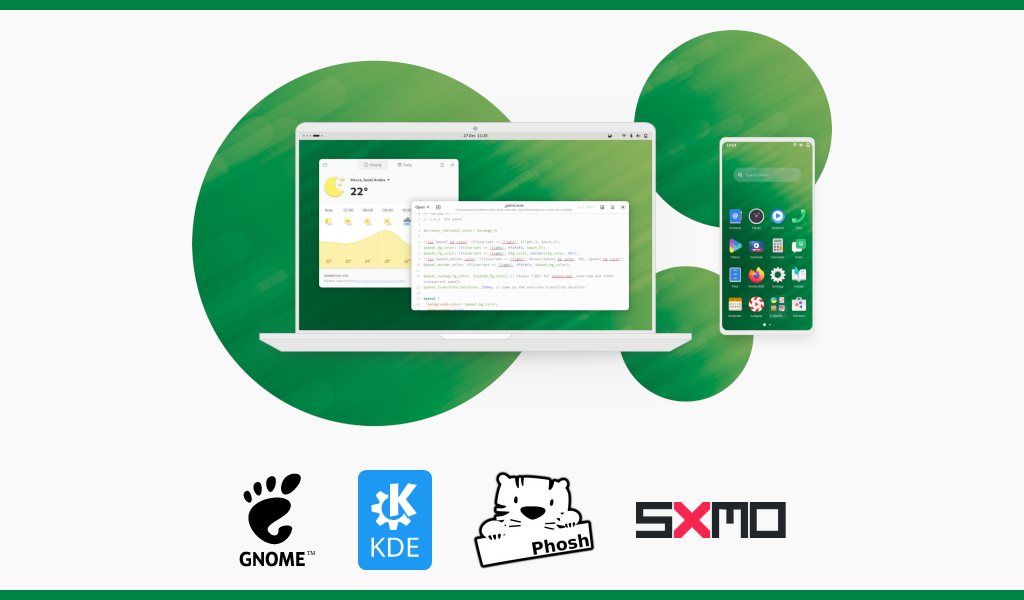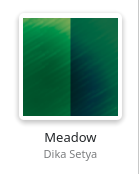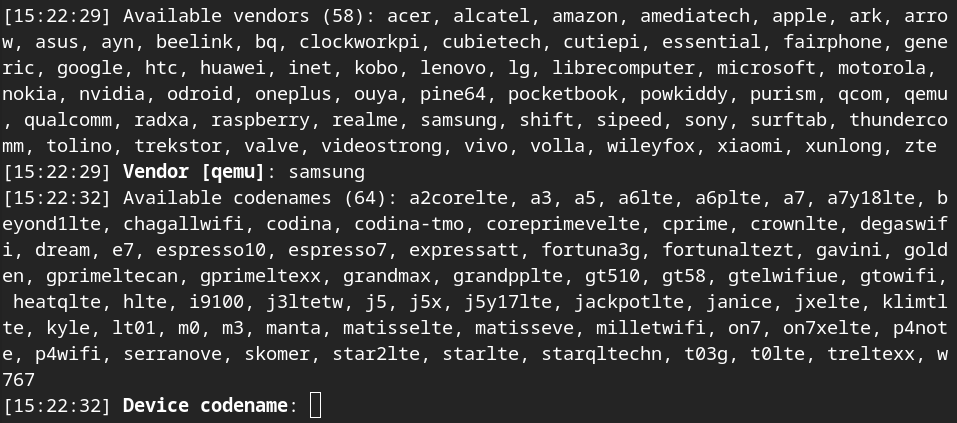This release is geared mainly towards Linux enthusiasts. We are working hard on stability improvements and automated testing, but if you expect Android or iOS levels of polish, then this is not for you yet.
Introduction
People are interested in running Linux on their devices for various reasons. We don't force you to set up an account on first boot. You are not urged to store all your private data in a cloud that you don't control. We don't pre-install or recommend software that tries to extract as much attention or money from you as possible. We don't follow AI hype trends that violate your privacy even further, implemented at the cost of a high environmental impact. What we do believe in is free software, giving you control over your device, and allowing you to use it way past the original vendor's support cycle!
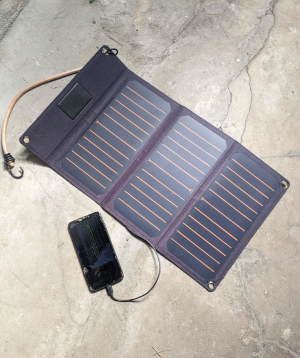
From Arne's Mastodon thread. Thank you for letting us show this in the release blog post!
On the note of upcycling, we had a lot of device ports in postmarketOS for a long time that could only be accessed through the bleeding edge version. But for the first time with v24.06, we have added most of them to the stable release. With a lot of them you can only barely boot Linux, but still it allows for some amazing use-cases:
i'm really excited to show https://compost.party to the world! it's a web server running on an old, broken phone, getting energy from the sun using one of those portable solar chargers that you may also have lying around.
it's a real oddity and a real beauty
Software Stack
As always we target the most recent Alpine release. In case of v24.06 it is the excellent Alpine Linux 3.20.
User Interfaces (UIs)
- GNOME Shell on Mobile 45_git20240610 replaces 45_git20230908 from v23.12. This version allows triggering the keyboard with double-tap on the bottom bar, and it has a new scheduling manager that improves UI smoothness. Thanks to @verdre, @azisu and all the GNOME contributors!
KDE Plasma Mobile 6.0.5 replaces version 5.27.10 from v23.12. After nearly 10 years since the first release of Plasma 5, the KDE MegaRelease 6 brings a huge number of improvements across the whole stack. Among other things, the homescreen has been rewritten for Plasma Mobile 6 and now allows users to customize pages with apps, folders and widgets, as well as using an app drawer and search. There is also a new welcome screen on first launch for setting up Wi-Fi, timezones, etc. Thanks to @EspiDev and all the KDE contributors!
Phosh 0.39 replaces version 0.33 from v23.12. Some of the highlights are folders in the app overview, better handling of devices with notches, selecting Wi-Fi networks via the quick settings and opening the on-screen keyboard via a long press on the bottom bar. Thanks to @agx and all the Phosh contributors!
Sxmo 1.16.3 replaces version 1.15.1 from v23.12. Among other things, this release has improvements in suspension control and brand new device configs for the Nokia N900, Xiaomi Redmi Note 4 and PineTab 2 (the PineTab 2 is currently only in edge but could be backported to v24.06). Thanks to @stacyharper, @sicelo and all the Sxmo contributors!
Notable Changes
- All UIs now feature the beautiful Meadow wallpaper by @dikasetyaprayogi, who also made the header image for this blog post, who's already made so many more amazing wallpapers that we can now switch to a new one with every postmarketOS release! Find previous wallpapers in the wiki. Thanks @dikasetyaprayogi for your amazing artwork, @stacyharper for adjusting Sxmo, @PureTryOut and @ollieparanoid for adjusting other UIs!
Chromebooks now have new keyboard mappings and the Samsung Chromebook now has GPU acceleration. Thanks @jenneron!
When building your own images, you can now also choose to install the interfaces cage (Kiosk compositor) and moonlight (Nvidia GameStream client). Thanks @vognev, @jenneron!
Logbookd is now the default logger, giving users an interface similar to journalctl for accessing logs. Thanks @MartijnBraam, @kcxt, @craftyguy!
The initramfs can now export logs on boot failure (!4646), supports USB network boot (!4947), and a stowaway rootfs (!4386) and received various fixes (!4705, !4775, !4907, !5089). Thanks @kcxt, @Arnavion, @jenneron, @craftyguy, @wonderfulShrineMaidenOfParadise, @the-SSD, @pabloyoyoista!
MSM8953 devices have received several improvements, among others for the modem (mobile data, calls, SMS) and GPS. Thanks @barni2000 and everybody who contributed!
Non-free firmware is now installed by default (edge post). Thanks @craftyguy!
If you still had it installed, osk-sdl has been removed and now automatically gets replaced with unl0kr (edge post). Thanks @cherrypicker, @okias, @craftyguy!
Removed hardcoded dependency on PulseAudio in UI packages. While PulseAudio is still the default for now (see milestone Switch to PipeWire), this allows to experiment with PipeWire. Thanks @craftyguy!
Lots of kernel upgrades, improvements and bug fixes for all devices. Thanks to all device maintainers and contributors!
Devices
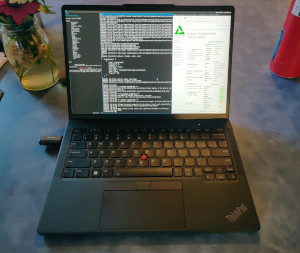
@craftyguy on the Thinkpad X13s:
"Doing some #postmarketOS development on a laptop running #postmarketOS. Is this allowed??"
Main And Community Categories
The amount of devices in main and community has been increased to 50 (from 45 since v23.12).
Among the new device ports are two generic ports: Generic x86_64 can be used on pretty much any PC or laptop and is now used by several people to develop for postmarketOS from postmarketOS, and Nvidia Tegra armv7 that can be used for multiple Tegra 2/3/4 devices such as various Asus Transformers, the Google Nexus 7 (2012), LG Optimus Vu, Microsoft Surface RT and WEXLER Tab 7t.
Thanks to all of our amazing device porters, and everybody who contributed!
- ASUS MeMO Pad 7
- Arrow DragonBoard 410c
- BQ Aquaris X5
- Fairphone 4
- Generic x86_64 new
- Google Chromebooks with x64 CPU
- Google Gru Chromebooks
- Google Kukui Chromebooks
- Google Nexus 10 new
- Google Oak Chromebooks
- Google Trogdor Chromebooks
- Google Veyron Chromebooks
- Lenovo A6000
- Lenovo A6010
- Lenovo ThinkPad X13s new
- Microsoft Surface RT new
- Motorola Moto G4 Play
- Nokia N900
- Nvidia Tegra armv7 new
- ODROID XU4
- OnePlus 6
- OnePlus 6T
- PINE64 PinePhone
- PINE64 PinePhone Pro
- PINE64 Pinebook Pro
- PINE64 RockPro64
- Purism Librem 5
- SHIFT6mq
- Samsung Chromebook
- Samsung Chromebook 2 11.6"
- Samsung Galaxy A3 (2015)
- Samsung Galaxy A5 (2015)
- Samsung Galaxy E7
- Samsung Galaxy Grand Max
- Samsung Galaxy S III (GT-I9300 and SHW-M440S)
- Samsung Galaxy S4 Mini Value Edition
- Samsung Galaxy Tab 2 10.1"
- Samsung Galaxy Tab 2 7.0"
- Samsung Galaxy Tab A 8.0
- Samsung Galaxy Tab A 9.7
- Wileyfox Swift
- Xiaomi Mi A1
- Xiaomi Mi A2 Lite
- Xiaomi Mi Note 2
- Xiaomi Pocophone F1
- Xiaomi Redmi 2
- Xiaomi Redmi 4 Prime
- Xiaomi Redmi 5 Plus
- Xiaomi Redmi Note 4
- Xiaomi Redmi S2/Y2
Testing Category
For the first time we have included devices from the "testing" category to a stable release of postmarketOS. 211 devices to be precise! As mentioned in the introduction, the quality of these ports varies from being able to barely boot to having most features working. Still it allows to run an up-to-date Linux distribution on old hardware, making your old phone at least as useful as a Raspberry Pi, but with a built-in battery.
To use these devices, build your own image with pmbootstrap. The binary packages from the v24.06 repository will be used, meaning you don't need to compile the Linux kernel or anything else. You can select your device during pmbootstrap init as shown in the screenshot. For very few of these we even have pre-build images.
The list of devices would be quite long, therefore refer to the device/testing directory. Find supported functionality per device in the wiki. Thanks to @Newbyte for fixing several kernels that were not compiling any more, to @ollieparanoid for including this in the stable release, and of course to all the amazing people that made these ports in the first place!
Device/UI Testing And Known Issues
A huge thank you to device maintainers and the testing team, and people who spontaneously decided to take part in testing this new release (#2861) and fixing bugs right before finalizing it! If you would like to join the fun next time, add yourself to the Testing Team.
While testing, the following issues were reported. They may not affect all users. If you are affected, then consider leaving a note in the related issue about it, especially if you have more information or could help with fixing it:
- PinePhone: SSH only works on 2nd connection, losing cellular signal over night (#2861)
- PinePhone: Wi-Fi may not work with combined WPA2/WPA3 access points (#2879)
- Librem 5: bluetooth not working with sparklan module (#2880)
- OnePlus 6: headphones are neither recognized automatically nor able to be selected manually (#2889)
- Fairphone 4: Wi-Fi connection often drops after a while (#2890)
- asus-tf201\nvidia-tegra-armv7: sensors require manual installation of the iio-sensor-proxy package (#2861)
- motorola-harpia: brief SMS received twice, continual clicking noise (#2861)
- MATE user interface:
onboardis broken (#2888) - The wallpaper might not auto-apply with Plasma (#2878).
- Plasma Bigscreen has been disabled, as it's not yet compatible with Plasma 6 (#2650)
- Androids: when booting from SD, the root partition does not get resized automatically (#2385)
How To Get It
New Installation
For new installs, see download and make sure to read the wiki page for your device.
Upgrade
For existing installations, see the upgrade to a newer postmarketOS release wiki article.
Recommended manual steps after upgrading:
- Sxmo: install
postmarketos-artwork-wallpapersto get the new wallpaper
Powered by
A big thanks to everybody who contributed to postmarketOS, to Alpine or to any of the numerous upstream components we use — without you this would not be possible! <3
We would also like to thank NLnet and NGI Zero Core for funding most of the infrastructure and maintenance work that went into this release. NLnet is funding a lot of great free software projects, including quite a few projects in the Linux Mobile world. If you would like to get your project funded, consider applying for a grant!
And what's next?
We target the v24.12 release for initial systemd support, as described in this blog post.
This year we started writing monthly blog posts to better highlight all the amazing things going on in our community! The next one will be out in July (skipping June due to the v24.06 release).
Members of the postmarketOS community and wider Linux Mobile scene can be found at various events this year, including FrOSCon, FOSSY, All Systems Go!, KDE's Akademy. For FrOSCon in particular, if you want to give a talk, do a BoF, a round table or similar please get in touch!
If you appreciate the work we're doing on postmarketOS, and want to support us, consider joining our OpenCollective.

